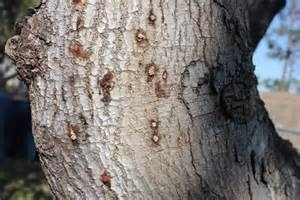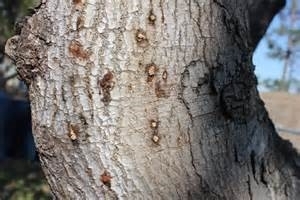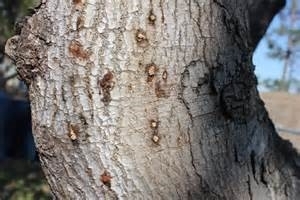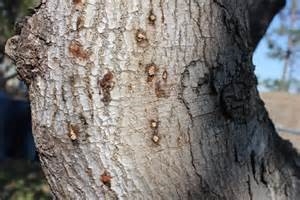- Author: Ben Faber
http://apsjournals.apsnet.org/doi/pdfplus/10.1094/PDIS-11-12-1026-RE
But here's the abstract:
The polyphagous shot hole borer (PSHB) is an invasive ambrosia bee-tle that forms a symbiosis with a new, Fusarium sp., together causing Fusarium dieback on avocado and other host plants in California and Israel. In California, PSHB was first reported on black locust in 2003 but there were no records of fungal damage until 2012, when a Fusarium sp.was recovered from the tissues of several backyard avocado trees infested with PSHB in Los Angeles County. The aim of this study was to determine the plant host range of the beetle–fungus complex in two heavily infested botanical gardens in Los Angeles County. Of the 335 tree species observed, 207 (62%), representing 58 plant families, showed signs and symptoms consistent with attack by PSHB. The Fusarium sp. was recovered from 54% of the plant species attacked by PSHB, indicated by the presence of the Fusarium sp. at least at the site of the entry hole. Trees attacked by PSHB included 11 species of California natives, 13 agriculturally important species, and many common street trees. Survey results also revealed 19 tree species that function as reproductive hosts for PSHB., approximately a quarter of all tree individuals planted along the streets of southern California belong to a species classified as a reproductive host. These data suggest the beetle–disease complex potentially may establish in a variety of plant communities locally and worldwide.
A PSHB conference is set for February 18 at the Huntington Library in San Marino. For registration contact:
http://ucanr.edu/sites/pshb/Events/
The damage

- Author: Ben Faber
Without a doubt the borers, PSHB and KSHB are going to hurt avocado production, but there are some California native and landscape trees that are also going to get hammered, like unto death. Much has been written about the borers in the press, from ag journals to environmental newsletters to newspapers, such as the New York Times, Los Angeles Times and more local papers like the Ventura Star and Riverside Press-Enterprise. Recent trap findings of PSHB in Ventura county brought a local gathering of community groups to discuss the situation and the need to get more information out to local residents of the major environmental disaster at our doorstep, It seems most homeowners are not aware of the problem or if so marginally so. Is it because it's viewed as just an avocado growers' problem? The CA Avocado Commission has lead in research and spending on this problem that will affect all citizens, not just growers and consumers of the fruit. Are we all just overwhelmed by the disasters that are occurring around us here and world-wide?
I'm not sure why the lack of general interest in this issue, but the only way to get control of these pests is to stop their movement, which is largely through humans moving contaminated wood. Slowing the spread will give time to develop control methods and measures that will allow our native woodlands to cope with this infestation. There are currently people looking for pathogens and parasites in the native range of these pests, in order to determine if those native control measure would fit into a California system. But this is going to take time and in the meantime the spread needs to be slowed. Talk to your neighbors, co-workers and friends. And have them talk to their neighbors, co-workers and friends. Get the word out about what we can all do to slow the spread.
Listed below are some of the common plants in which the borer can reproduce and spread its fungi that kill the tree. Many more trees have been identified to which the borer goes, but as yet it's not known whether the fungi spread in those trees.
Known Suitable Reproductive Host Trees of PSHB:
2. Big leaf maple (Acer macrophyllum)*
3. Evergreen Maple (Acer paxii)
4. Trident maple (Acer buergerianum)
5.Japanese maple (Acer palmatum)
6. Castor bean (Ricinus communis)
7. California Sycamore (Platanus racemosa)*
8. Mexican sycamore (Platanus mexicana)
9. Red Willow (Salix laevigata)*
10. Avocado (Persea americana)
11. Mimosa (Albizia julibrissin)
12. English Oak (Quercus robur)
13. Coast live oak (Quercus agrifolia)*
14. London plane (Platanus x acerifolia)
15.Cottonwood (Populus fremontii)*
16. Black cottonwood (Populus trichocarpa)*
17. White Alder (Alnus rhambifolia)*
18.Titoki (Alectryon excelsus)
19. Engelmann Oak (Quercus engelmannii)*
20. Cork Oak (Quercus suber)
21. Valley oak (Quercus lobata)*
22. Coral tree (Erythrina corallodendon)
23. Blue palo verde (Cercidium floridum)*
24. Palo verde (Parkinsonia aculeata)
25. Moreton Bay Chestnut (Castanospermum australe)
26. Brea (Cercidium sonorae)
27. Mesquite (Prosopis articulata)*
28. Weeping willow (Salix babylonica)
29. Chinese holly (Ilex cornuta)
30. Camelia (Camellia semiserrata)
31. Acacia (Acacia spp.)
32. Liquidambar (Liquidambar styraciflua)
33. Red Flowering Gum (Eucalyptus ficifolia)
34. Japanese wisteria (Wisteria floribunda)
35. Goodding's black willow (Salix gooddingii)*
36. Tree of heaven (Alianthus altissima)
37. Kurrajong (Brachychiton populneus)
38. Black mission fig (Ficus carica)
Known Suitable Reproductive Host Trees of KSHB
1. Avocado (Persea americana)
2. California Sycamore (Platanus racemosa)*
3. Coast live oak (Quercus agrifolia)*
4. Cork oak (Quercus suber)
5. Draft coral tree (Erythrina humeana)
- Black Polar (Populus nigra)
7. Black locust (Robinia pseudoacacia)
8. Red Willow (Salix laevigata)*
- Arroyo willow (Salix lasolepis)*
- Cottonwood (Populus fremontii)*
11. Mimosa (Albizia julibrizin)
12. Castor bean (Ricinus communis)
13. Black Willow (Salix nigra)*
14. Strawberry Snowball Tree (Dombeye cacuminum)
*Native species to California
For other information sources of what these new borers can do to our wildscapes check out:
http://ucanr.edu/sites/socaloakpests/

- Author: Ben Faber
A note from UC Riverside Plant Pathologist, Akif Eskalen
Hello,
We just confirmed that the riparian forest in the Tijuana river valley in San Diego is infested with Kuroshio Shot Hole Borer. Rod Dossey and his team from WRA, Environmental Consultants first noticed the sign and symptoms of the beetle on Sept 25th, and contacted us for the confirmation. I have visited the site last week and mortality is already occurring on many trees including Arroyo Willow, Black Willow and Castor Bean. Please let me know if you have any questions.
PSHB/KSHB distribution map
http://ucanr.maps.arcgis.com/apps/Viewer/index.html?appid=3446e311c5bd434eabae98937f085c80
Regards
Akif

- Author: Akif Eskalen
FUSARIUM DIEBACK AND POLYPHAGOUS SHOT HOLE BORER ON AVOCADO
Akif Eskalen1, Richard Stouthamer2
1Department of Plant Pathology and Microbiology, UC Riverside
2Department of Entomology, UC Riverside
BACKROUND
Polyphagous shot hole borer (PSHB), Euwallacea sp. (#1) (Fig.1) is an invasive beetle that carries three fungal symbionts in a special structure in their mouth called a mycangium. These symbiotic fungi are Fusarium euwallaceae, Graphium euwallaceae and Acremonium pembeum (Freeman et al. 2013, Lynch et al. 2015). The adult female tunnels galleries into a wide variety of host trees, where it lays its eggs and grows the fungi (Fig.2, 3). The fungi cause the Fusarium Dieback (FD) disease, which interrupts the transport of water and nutrients in over 38 tree species that are suitable for beetle reproduction. A separate invasion was recently detected in San Diego county and is now being called Kuroshio shot hole borer (KSHB) and is another closely related species to PSHB (Euwallacea sp. (#5)) carrying two new fungal species - Fusarium and Graphium. Both species have been found causing damage on avocado in the los Angeles basin and San Diego County.
BEETLE BIOLOGY
Adult females of PSHB and KSHB (Fig. 1) are black in color and 1.8-2.5 mm long. Adult males (Fig. 4 ) are brown and smaller than females at 1.5 mm long. More females are produced than males, which are flightless and very rarely leave the galleries. Mature siblings mate with each other so that females are already pregnant when they leave to start their own galleries. Males do not fly, but stay in the host tree.
SYMPTOM AND SIGNS
External Symptoms: Attack symptoms, a host tree's visible response to stress, vary among host species. Staining (Fig. 5), sugary exudate ( also called a sugar volcano) (Fig. 6-7), gumming (Fig.8), and/or frass (Fig. 9) may be noticeable before seeing the tiny beetles. Beneath or near these symptoms, you may also see the beetle's entry/exit holes, which are ~0.85 mm in diameter Fig 10). The abdomen of the female beetle can sometimes be seen sticking out of the hole. Advanced fungal infections will eventually lead to branch dieback, as seen on this Avocado (Fig. 11).
Internal Symptoms: Fungal species associated with the beetle PSHB and KSHB cause brown to black discoloration in infected wood. Discolored wood can easily be seen when bark is scraped away around the entry/exit hole (Fig 10). Cross-sections of cut branches (Fig. 12) show the extent of infection.
KNOWN REPRODUCTIVE HOSTS OF PSHB and KSHB
PSHB attacks hundreds of tree species, but it can only successfully lay its eggs and/or grow the fungi in certain hosts.
Known Suitable Reproductive Host Trees of PSHB:
- Avocado (Persea americana)
- Box elder (Acer negundo)
- California Sycamore (Platanus racemosa)
- Big leaf maple (Acer macrophyllum)
- Evergreen Maple (Acer paxii)
- Trident maple (Acer buergerianum)
- Japanese maple (Acer palmatum)
- Castor bean (Ricinus communis)
- Mexican sycamore (Platanus mexicana)
- Red Willow (Salix laevigata)
- Mimosa (Albizia julibrissin)
- English Oak (Quercus robur)
- Coast live oak (Quercus agrifolia)
- London plane (Platanus x acerifolia)
- Cottonwood (Populus fremontii)
- Black cottonwood (Populus trichocarpa)
- White Alder (Alnus rhambifolia)
- Titoki (Alectryon excelsus)
- Engelmann Oak (Quercus engelmannii)
- Cork Oak (Quercus suber)
- Valley oak (Quercus lobata)
- Coral tree (Erythrina corallodendon)
- Blue palo verde (Cercidium floridum)
- Palo verde (Parkinsonia aculeata)
- Moreton Bay Chestnut (Castanospermum australe)
- Brea (Cercidium sonorae)
- Mesquite (Prosopis articulata)
- Weeping willow (Salix babylonica)
- Chinese holly (Ilex cornuta)
- Camelia (Camellia semiserrata)
- Acacia (Acacia spp.)
- Liquidambar (Liquidambar styraciflua)
- Red Flowering Gum (Eucalyptus ficifolia)
- Japanese wisteria (Wisteria floribunda)
- Goodding's black willow (Salix gooddingii)
- Tree of heaven (Alianthus altissima)
- Kurrajong (Brachychiton populneus)
- Black mission fig (Ficus carica)
Known Suitable Reproductive Host Trees of KSHB:
- Avocado (Persea americana)
- California Sycamore (Platanus racemosa)
- Big leaf maple (Acer macrophyllum)
- Coast live oak (Quercus agrifolia)
- Cork oak (Quercus suber)
- Coral tree (Erythrina humeana)
COMMENTS OF THE PEST AND DISEASE COMPLEX
Fusarium dieback (FD) is a new, invasive, beetle-vectored disease that has caused damage on avocado and other host trees in urban forests and wild lands in the Los Angeles basin since early 2012, and Orange and San Diego County since early 2013. This pest/disease complex has also impacted the avocado growing regions of Israel since 2009. DNA analyses of polyphagous shot hole borer (PSHB) beetles indicate that those from San Diego County are different from those in Los Angeles.and these beetles are now being called Kuroshio shot hole borer (KSHB) and are genetically similar to a beetle population in Taiwan. The beetles from Israel and the Los Angeles basin are genetically similar to those from Vietnam (Stouthamer unpublished data). Other studies have shown that species of Euwallacea, as well as thefusariumfungi they cultivate, are genetically distinct, including those from the Los Angeles basin (which are identical to those in Israel) and San Diego (O'Donnell 2014). These results indicate that at least two introductions into California have occurred. Each beetle carries its own novel pathogenic fungal species of Fusarium and Graphium, while the beetle from Los Angeles additionally carries a species of Acremonium (Lynch et al. in press).
Rapid spread of the beetle/fungi throughout various land use areas is attributed to the diverse range and quantity of suitable hosts in Southern California (Eskalen et al., 2013). Establishment of the beetle is a source of concern for the avocado industry, of which 90% of the United States crop is produced in California (California Avocado Commission). Several commercial avocado groves in Los Angeles County have been infested since 2012. The second invasion in San Diego County was not detected in commercial avocado groves until October 2014, one year after the initial finding on sycamore in El Cajon. Since then, 20 commercial avocado groves in San Diego County have been confirmed infested.
MANAGEMENT
Currently there are no control measures to control this pest. Early detection of infestation helps reduce the population of the beetle by removing infested branches where beetle can reproduce their offspring.
-If the infestation is on the branch collar, cut into branch collar and spray pruning wounds with a registered product of Bacillus subtilus.
-Chip infested wood on-site to a size of one inch or smaller. If the branch is too large to chip, solarize them under a clear tarp for several months
-Sterilize tools to prevent the spread of the disease with either 25% household bleach, Lysol® cleaning solution, or 70% ethyl alcohol.
-Avoid movement of infested firewood and chipping material out of infested area.
-For more information visit http://eskalenlab.ucr.edu
The insect and the damage on avocado


- Author: Jim Downer
As we continue an historic drought in California, trees all over Southern California are showing symptoms of stress, and in some cases have died due to drought and pests that attack drought stressed trees. Despite recent and significant rainstorms, it is likely that trees will again be stressed later in the irrigation season. Trees and other woody plants in nurseries also bear the burden of drought stress as irrigation waters become increasingly salty because of drought effects on wells and reliance on stored water in reservoirs continues.
The Polyphagous shot hole borer is a serious pest of nursery and landscape trees and threatens many species. As such, counties adjacent to Los Angeles are at risk of invasion by this new exotic pest and we are watching and monitoring trees for possible extant new detections. The drought has stressed many of the signature trees that could be attacked by PSHB and these trees are often attacked by native or established pests. In some cases these beetles closely resemble PSHB and cause symtpoms of bleeding and in some cases cambial discoloration and gallery formation similar to that of PSHB.
On coast live oak (Quercus agrifolia) there are two look alike beetles the western oak bark beetle (Pseudopityophthorus pubipenis) and the Oak ambrosia beetle (Monarthrum scutellare). The western oak bark beetle is common in Southern California and the ambrosia beetle more common in the northern half of the state but both have been detected throughout California. As with many beetle/tree interactions both of these are attracted to drought stressed trees. When attacked coast live oak bleeds heavily and these insects often attack in larger numbers uniformly along the main stems or trunk. Examination of the cambium of Oak Bark Beetle attacked trees reveals small galleries and little or no necrotic tissue.
Prunus spp such as peach, nectarine, plum and apricot are common in back yards and retail nurseries. This year we are seeing much increased attack of these trees by the European fruit borer or shot hole borer (Scolytus rugulosus) a beetle very similar in stature to PSHB. The insect is the same size as PSHB and makes numerous holes and causes excessive bleeding in Prunus. This insect also seems to carry a fungal pathogen resulting in cambial necrosis.
One other insect that could be mistaken for PSHB is the walnut twig borer which vectors Thousand Cankers Disease of walnuts (both native and English). This beetle (Pityophthorus juglandis) carries with it a fungus Geosmithia morbida, that causes extensive cambial necrosis, and ultimately twig and branch dieback results from its presence.




